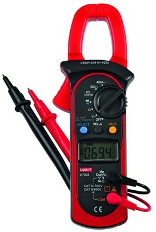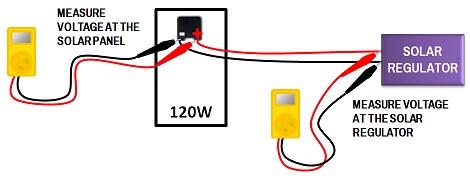Testing Cabling
We see it so often: the battery isn't giving enough power, the fridge isn't keeping food cool, the solar panels aren't bringing in power. It could be that cabling is the cause of the problem. To test cabling, you really need a multimeter. Let's go over what to look for and our recommendation.
Multimeter
A multimeter measures voltage in AC or DC, resistance in a number of different ranges, and current.
Some multimeters require the leads to be connected in a different position to measure amps in AC or DC. These carry the risk of you forgetting to change the leads back to where they should be. If you measure amps when the leads are in position to measure voltage, or voltage when the leads are in position to measure amps, you will blow up your multi meter.
Clamp multimeter
For a few more dollars. you can buy a clamp multimeter which uses the probes to measure voltage, resistance and a few other things and the clamp part can go over the wire - so the wire doesn't need to be disconnected - and give you a reading of how many amps are flowing through the wire.
Some caution is required with the selection of a meter for this purpose, because some measure AC current accurately, but not DC current and others measure DC current accurately, but not so much AC current. For general DC use, where precision down to the last decimal point isn't really necessary, we've found that the UNI-T UT203 does the job and is fairly robust.
A really good quality brand is Fluke. They are very good, but very expensive and rather fragile.

UNI-T UT203
How to use a clamp multimeter
- For an accurate measurement, put the multimeter near the wire you want to check but not over it. Press the REL button and this will zero out anything the multimeter could be reading in the surrounding area (there's always a bit of electricity floating around), then clamp the meter over the top of the wire:
- If, on the left hand side, the minus sign appears, flip the meter over.
- If you want to get really accurate, put the clamp on each way and average the two readings.
- If you want to read very small current, wrap the wire around the tong of the clamp. Divide the reading by the number of times you wrap the wire around. This increases the accuracy of the reading.
Testing cabling from solar panels to battery
This test is best suited if you have a PWM solar controller, and is for determining if and where you might have a wiring problem.
On a good solar day, when you've got good sun coming onto your panels:
- Use a multimeter to measure the voltage at the back of one of your panels.
- Now measure the voltage where the solar comes into the solar regulator in your RV.
- Next, take a reading of the battery voltage.

If there is a voltage drop anywhere between these 3 readings, your wiring is substandard and adding more solar isn't going to help much.

A simple way to test each individual panel without needing a multimeter and things to check for which could mean you have a dead panel. We also go over how to test the cabling from your panels to your solar controller with a multimeter.
Maybe you suspect that your RV battery, or one in a set of paralleled batteries, is on the way out. With just a mains charger and some time, it's possible to diagnose the health of a battery.